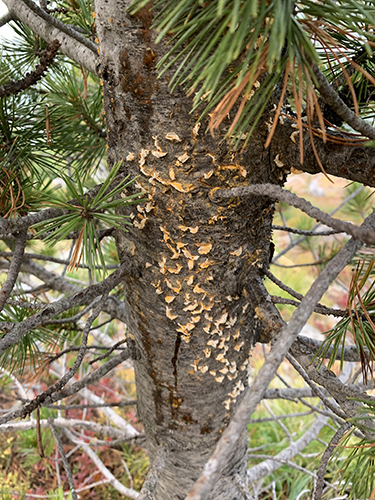White Pine Blister Rust

White pine blister rust (Cronartium ribicola) is a non native introduced fungal disease affecting North American white pine trees. The fungus is native to Cyberia and has been present in the west since the turn of the century; likely introduced from Ribes spp. brought in as ornamentals from Europe. The disease spreads from cool and moist conditions usually in late summer and rapidly spreads over long distances.
White pine blister rust generally needs a five needle pine like eastern white pine and a currant or gooseberry to complete its lifecycles. Since 2006, however, research has discovered there are at least a couple of species besides Ribes that Can be an alternate host for the rust. This includes indian paint brush (Castillija spp.), snapdragon (Pedicularis spp.), and possibly others. The disease had made a considerable economic impact on the white pine lumber industry and both ecological and aesthetic impacts on white bark pine, sugar pine, bristlecone pine, eastern white pine, and western white pine.
Diagnosis
- Kills Branches, tree tops, and whole trees of five needle pine
- Causes leaf loss and leaf spots of currant and gooseberry
- Needles turn yellow then rusted red with many tiny dots
- Swollen discoloured or cracked areas on trunk or branches (canker)
- Sticky clear to white resin oozing from cankers
- chewing from rodents on resinous areas (due to sweetness of the sap)
How it works
Spores from the Ribes shrubs are carried on cool, moist air currants in late summer to early fall. They land on pine needles, entering them through the stomata or wounds. In the spring, they become infected, turn brown and may fall off. Within a few years the fungus moves to branches creating cankered areas. It then progresses towards the main trunk at a rate of about 3 inches per year. If the fungus girdles the main trunk it can kill entire young trees. Only tree tops and branches are killed on older trees. The fist summer after infection, gummy orange spores may be present on the cankers. The following spring, white blisters at the edges of cankers form, crack open to release spores (powdery yellowish orange). These then infect Ribes spp. Shrubs.
After infection it creates a new type of spore on the underside of Ribes leaves (urediniospores), these produce new leaf spots on the crown and other nearby Ribes shrubs. When the season cools, white hairs are produced on the spores (cilia). These produce another type of spore called basidiospores which are dispersed by cool moist air currants to again infect white pine trees.
Care
- Prune diseased branches before 4 inches of the main trunk
- Select disease resistant gooseberries or currants
- Select disease resistant white pine trees
- Plant to provide adequate space for air circulation
- Prune lower branches slowly as trees mature
- Avoid overhead irrigation
- Avoid planting in low, cool areas
References
High Elevation White Pines. (n.d.). White Pine Blister Rust. Retrieved from https://www.fs.fed.us/rm/highelevationwhitepines/Threats/blister-rust-threat.htm
Natural Resources Canada. (2019). White pine blister rust. Retrieved from https://www.ontario.ca/page/white-pine-blister-rust
Ontario. (2020). White pine blister rust. Retrieved fromhttps://www.ontario.ca/page/white-pine-blister-rust
University of Minnesota Extension. (2019). White pine blister rust. Retrieved from https://extension.umn.edu/plant-diseases/white-pine-blister-rust